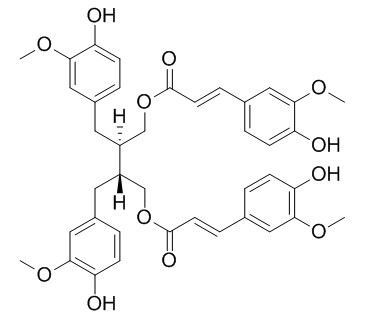9,9'-Di-O-(E)-feruloylsecoisolariciresinol
1,4-O-Diferuloylsecoisolariciresinol(9,9'-Di-O-(E)-feruloylsecoisolariciresinol),and pierreione B, two novel inhibitors of mTOR signaling, have strong anticancer activity. (+)-9,9′-O-Diferuloylsecoisolariciresinol has significant cytotoxic activity against the DU145, LNCaP, and A549 cell lines.
Inquire / Order:
manager@chemfaces.com
Technical Inquiries:
service@chemfaces.com
Tel:
+86-27-84237783
Fax:
+86-27-84254680
Address:
1 Building, No. 83, CheCheng Rd., Wuhan Economic and Technological Development Zone, Wuhan, Hubei 430056, PRC
Providing storage is as stated on the product vial and the vial is kept tightly sealed, the product can be stored for up to
24 months(2-8C).
Wherever possible, you should prepare and use solutions on the same day. However, if you need to make up stock solutions in advance, we recommend that you store the solution as aliquots in tightly sealed vials at -20C. Generally, these will be useable for up to two weeks. Before use, and prior to opening the vial we recommend that you allow your product to equilibrate to room temperature for at least 1 hour.
Need more advice on solubility, usage and handling? Please email to: service@chemfaces.com
The packaging of the product may have turned upside down during transportation, resulting in the natural compounds adhering to the neck or cap of the vial. take the vial out of its packaging and gently shake to let the compounds fall to the bottom of the vial. for liquid products, centrifuge at 200-500 RPM to gather the liquid at the bottom of the vial. try to avoid loss or contamination during handling.
Molecules.2019, 24(17):E3127
J Med Food.2016, 19(12):1155-1165
Food Res Int.2019, 123:125-134
Pharmaceuticals (Basel).2021, 14(7):633.
Journal of Food and Drug Analysis2023, 31(3), 9.
Evid Based Complement Alternat Med.2016, 2016:1739760
Int J Mol Sci.2022, 23(11):6172.
Korean J. of Food Sci. and Tech2016, 172-177
Food Bioscience2022, 50:102187.
J Microbiol Biotechnol.2023, 33(10):1317-1328.
Related and Featured Products
Chemistry of Natural Compounds, 2014, 50(6): 978-81.
Phytochemical Investigation and Cytotoxic Evaluation of Components of Leaves and Stems of Machilus zuihoensis var. mushaensis[Reference:
WebLink]
METHODS AND RESULTS:
From the MeOH extract of the leaves and stems of Machilus zuihoensis var. mushaensis, one new lignan, machilolin-B (1), together with 10 known compounds, zuonin B (2), (+)-9,9′-O-diferuloylsecoisolariciresinol (9,9'-Di-O-(E)-feruloylsecoisolariciresinol,3), (E)-3-(3-hydroxybut-1-enyl)-2,4,4-trimethylcyclohexa-2,5-dienone (4), 5-[(1R,5R,8S)-8-hydroxy-1,5-dimethyl-3-oxo-6-oxabicyclo[3.2.1]oct-8-yl]-3-methyl-2,4-pentadienoic acid (5), vanillin (6), rhamnetin-3-O-β-D-galactopyranoside (7), 2-hydroxy-3,4-dioxopentanal (8), a mixture of β-sitosterol (9) and stigmasterol (10), and β-sitosteryl-β-D-glucoside (11), have been isolated.
CONCLUSIONS:
Among them, compound 3 was demonstrated to have significant cytotoxic activity against the DU145, LNCaP, and A549 cell lines. Compound 11 also possessed moderate antiproliferative activities against DU145 cell lines.
Cancer Chemother Pharmacol. 2013 Oct;72(4):799-808.
Identification of two novel inhibitors of mTOR signaling pathway based on high content screening.[Pubmed:
23934262]
Mammalian target of rapamycin (mTOR) signaling pathway plays a critical role in regulating cell growth, proliferation and survival. Dysregulation of mTOR signaling pathway is closely involved in cancer development and chemotherapy resistance. Inhibitors of mTOR signaling pathway have been demonstrated to be attractive therapeutics for cancer therapy. In the present study, we aim to discover novel mTOR signaling pathway inhibitors from a natural compound library.
METHODS AND RESULTS:
Inhibitors of mTOR signaling pathway were discovered via high content screen assay based on the subcellular localization of eukaryotic initiation factor 4E (eIF4E) in mouse embryonic fibroblast cells. Candidate compounds were further assessed in cancer cells. Phosphorylation levels of mTOR complexes downstream targets were analyzed using Western blot. Cell cytotoxicity and apoptosis were evaluated using MTS assay and flow cytometry, respectively. Two compounds, 1,4-O-diferuloylsecoisolariciresinol (9,9'-Di-O-(E)-feruloylsecoisolariciresinol,IM-1) and Pierreione B (IM-2), were identified which induced significant nuclear translocation of eIF4E in a panel of cancer cells. Both of the compounds decreased the phosphorylation levels of p70 ribosomal protein S6 kinase (S6K) and eIF4E binding protein 1 (4E-BP1), resulting in cancer cell cytotoxicity and apoptosis.
CONCLUSIONS:
Via high content screen assay, two novel inhibitors of mTOR signaling, IM-1 and IM-2, were identified with strong anticancer activity. IM-1 and IM-2 could be potential candidates for anticancer therapeutics by targeting mTOR signaling pathway and as such warrants further exploration.



